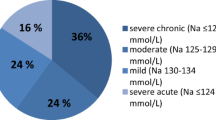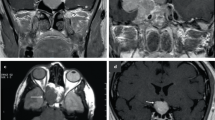Abstract
Purpose
Hypopituitarism frequently develops following vasculotoxic snake bite complicated by acute kidney injury (AKI). Well defined prospective studies of prevalence of hypopituitarism and its predictors in vasculotoxic snake bites complicated by AKI are unavailable.
Methods
Fifty-one consecutive patients of AKI following vasculotoxic snake bite were evaluated for various clinical/biochemical parameters (including Free T4, TSH, Cortisol, ACTH, total testosterone, FSH, LH, prolactin, and IGF-1). Diabetes insipidus was evaluated in relevant cases. Twenty minutes whole blood clotting time (WBCT) at presentation was measured in all. MRI of hypothalamo-pituitary region was done at 3 months in subjects with hypopituitarism to rule out structural lesion.
Results
21.6% (11/51) patients developed hypopituitarism at baseline (within 7 days), 39.3% (13 /33) at 3 months developed hypopituitarism. Cortisol deficiency was the commonest abnormality. Subjects who developed hypopituitarism at baseline were younger compared to those without hypopituitarism (35.67 years vs. 46.59 years, p = 0.032) and required more sessions of hemodialysis (8 vs. 3, p = 0.041). Binary logistic regression confirmed that development of hypopituitarism could be predicted by increased number of sessions of hemodialysis (OR 1.51, p = 0.008) and 20 min WBCT (OR 1.2, p = 0.038).
Conclusion
Hypopituitarism is common following vasculotoxic snake bite in subjects who develop AKI requiring hemodialysis. Hypopituitarism can develop as early as 7 days following snake bite and should be evaluated for particularly in younger subjects, especially those requiring increasing number of sessions of hemodialysis and in subjects with abnormal 20 min WBCT at presentation.
Similar content being viewed by others
References
Kalra S, Dhanwal D, Khadilkar V (2011) Hypopituitarism in the tropics. Indian J Endocrinol Metab 15(3):151
Gundgurthi A, Garg MK, Bhardwaj R, Brar KS, Kharb S, Pandit A (2012) Clinical spectrum of hypopituitarism in India: a single center experience. Indian J Endocrinol Metab 16:803–808
Warrel DA (2010) Guidelines for the management of snake. World Health Organization. https://apps.searo.who.int/PDS_DOCS/B4508.pdf. Accessed 13 Oct 2019
Antonypillai CN, Wass JA, Warrell DA, Rajaratnam HN. Hypopituitarism following envenoming by Russell's vipers (Daboia siamensis and D. russelii) resembling Sheehan's syndrome: first case report from Sri Lanka, a review of the literature and recommendations for endocrine management.QJM. 2011; 104 (2):97–108.
Pe T, Phillips RE, Warrell DA, Moore RA, Swe TN, M Lwin, Burke CW. Acute and chronic pituitary failure resembling Sheehan's syndrome following bites by Russell's viper in Burma. Lancet. 1987; 2(8562):763–7.
Lwin M, Warrell DA, Phillips RE, Swe TN, Pe T, Lay MM (1985) Bites by Russell's viper (Vipera russelli siamensis) in Burma: haemostatic, vascular, and renal disturbances and response to treatment. Lancet 2(8467):1259–1264
KDIGO Clinical Practice Guideline for Acute Kidney Injury. (2012); 2, Suppl 1. https://kdigo.org/wp-content/uploads/2016/10/KDIGO-2012-AKI-Guideline-English.pdf. Accessed 13 Oct 2019
Isbister GK, Maduwage K, Shahmy S, Mohamed F, Abeysinghe C, Karunathilake H, Ariaratnam CA, Buckley NA (2013) Diagnostic 20-min whole blood clotting test in Russell's viper envenoming delays antivenom administration. QJM 106(10):925–932
Benjamin JM, Chippaux JP, Sambo BT, Massougbodji A (2018) Delayed double reading of whole blood clotting test (WBCT) results at 20 and 30 minutes enhances diagnosis and treatment of viper envenomation. J Venom Anim Toxins Incl Trop Dis 24:14
Golay V, Roychowdhary A, Dasgupta S, Pandey R (2014) Hypopituitarism in patients with vasculotoxic snake bite envenomation related acute kidney injury: a prospective study on the prevalence and outcomes of this complication. Pituitary 17(2):125–131
Naik BN, Bhalla A, Sharma N, Mokta J, Singh S, Gupta P, Rai A, Subbiah S, Bhansali A, Dutta P (2018) Pituitary dysfunction in survivors of Russell's viper snake bite envenomation: A prospective study. Neurol India 66(5):1351
Shivaprasad C, Aiswarya Y, Sridevi A, Anupam B, Amit G, Rakesh B, Annie PA, Anish K (2019) Delayed hypopituitarism following Russell's viper envenomation: a case series and literature review. Pituitary 22(1):4–12
Rajagopala S, Thabah MM, Ariga KK, Gopalakrishnan M (2015) Acute hypopituitarism complicating Russell’s viper envenomation: case series and systematic review. QJM 108(9):719–728
Bates AS, Van't Hoff W, Jones PJ, Clayton RN (1996) The effect of hypopituitarism on life expectancy. J Clin Endocrinol Metab 81(3):1169–1172
Grace M, Shanoj KC (2014) An unusual complication of snake bite. Egypt J Intern Med 26:91–92
Acknowledgements
We acknowledge the research grant provided by Endocrine Society of Bengal, a state affiliate of Endocrine Society of India for conducting the study.
Author information
Authors and Affiliations
Corresponding author
Ethics declarations
Conflict of interest
The authors declare that they have no conflicts of interest.
Additional information
Publisher's Note
Springer Nature remains neutral with regard to jurisdictional claims in published maps and institutional affiliations.
Rights and permissions
About this article
Cite this article
Bhat, S., Mukhopadhyay, P., Raychaudhury, A. et al. Predictors of hypopituitarism due to vasculotoxic snake bite with acute kidney injury. Pituitary 22, 594–600 (2019). https://doi.org/10.1007/s11102-019-00990-8
Published:
Issue Date:
DOI: https://doi.org/10.1007/s11102-019-00990-8




